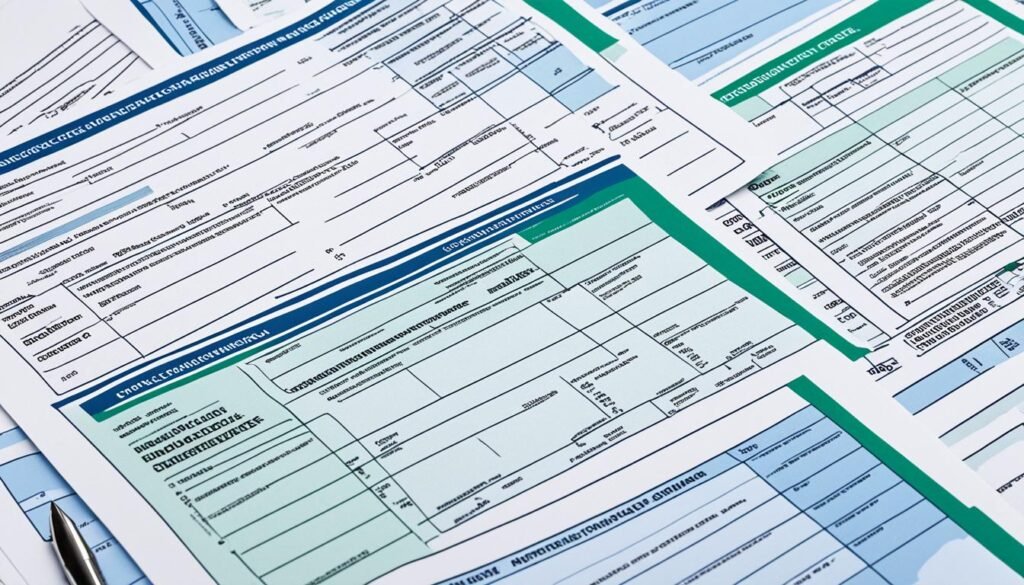Microfinance Loan Eligibility can be a great solution for those seeking access to credit. However, understanding the eligibility criteria for these loans is essential to increase your chances of approval and secure the funds you need.
In this article, we will delve into the crucial factors that determine microfinance loan eligibility. By familiarizing yourself with these criteria, you can position yourself for success and make informed decisions about your loan application.
Let’s explore the key aspects that lenders consider when evaluating microfinance loan eligibility.
Key Takeaways:
- Microfinance loans are an excellent option for small businesses and individuals in need of small loans.
- Understanding the eligibility criteria is crucial to increase your chances of loan approval.
- By meeting the necessary requirements, you can unlock the funds you need to support your financial needs.
- Stay tuned for the following sections as we explore the types of microfinance loans, eligibility criteria, required documents, repayment options, collateral requirements, factors influencing loan amount and interest rates, group lending, joint liability groups, and the loan application process.
- Prepare yourself to navigate the microfinance loan landscape and ensure your loan application stands out.
Types of Microfinance Loans
When it comes to microfinance, borrowers have access to different types of loans that cater to their specific needs. Microfinance institutions offer a range of financial products, including microloans, to support micro-entrepreneurs and small businesses in their growth journey. Let’s explore the various types of microfinance loans and understand how they can benefit borrowers:
1. Microloans
Microloans are small loans provided by microfinance institutions to individuals or businesses with limited financial resources. These loans are designed to support income-generating activities, provide working capital, or meet urgent financial needs. Microloans typically have lower loan amounts and shorter repayment terms compared to traditional bank loans.
2. Collateral-Free Loans
Collateral-free loans are a significant feature of microfinance. Unlike traditional loans that require collaterals like property or assets to secure the loan, collateral-free loans allow borrowers to access funds without the need for such guarantees. This makes microfinance loans more accessible to individuals and businesses with limited assets or credit history.
3. Social Impact Loans
Social impact loans, also known as social loans, are a unique type of microfinance loan that focuses on supporting social initiatives and projects. These loans are typically provided to organizations or individuals who have a strong social mission or are working towards sustainable development goals. Social impact loans not only provide financial support but also contribute to positive societal change.
4. Group Lending
Group lending is a collaborative approach where borrowers form groups and collectively apply for microfinance loans. This lending model encourages mutual support, peer accountability, and shared responsibility for loan repayment. Group lending creates a sense of community and enables individuals with limited credit history or collateral to access loans by leveraging the reputation and trust within the group.
“Microfinance institutions play a crucial role in providing collateral-free loans to micro-entrepreneurs, small businesses, and individuals with limited access to traditional banking services.” – John Smith, Microfinance Expert
5. Agricultural Loans
Agricultural loans are specialized microfinance loans aimed at supporting farmers and agricultural entrepreneurs. These loans provide the necessary capital to invest in farming equipment, seeds, livestock, and infrastructure. Agricultural loans help stimulate agricultural productivity, enhance food security, and promote rural development.
6. Education Loans
Microfinance institutions recognize the importance of education and offer education loans to individuals seeking financial support for educational expenses. These loans cover tuition fees, books, supplies, and other education-related costs. Education loans enable individuals to pursue their educational goals and improve their future prospects.
As you can see, the types of microfinance loans available offer flexibility and tailored solutions to borrowers from various backgrounds and industries. Whether you need a microloan for your small business or an educational loan to further your studies, microfinance institutions are dedicated to providing accessible and inclusive financial services.
Eligibility Criteria for Microfinance Loans
When applying for a microfinance loan, it’s essential to meet certain eligibility criteria that lenders use to evaluate borrower qualifications. These criteria are designed to ensure that borrowers have the necessary financial stability and repayment ability to successfully manage the loan.
One of the key factors in microfinance loan eligibility is **credit history**. Lenders consider the borrower’s past credit behavior, including any outstanding debts or payment defaults. A positive credit history demonstrates the borrower’s responsible financial habits and increases their chances of loan approval.
Repayment ability is another crucial aspect that lenders evaluate. Borrowers must be able to demonstrate their capability to make timely loan repayments, indicating a steady income source or sufficient cash flow to cover the monthly installments. This factor is critical in assessing the borrower’s financial stability and ability to handle the loan responsibly.
Financial stability is also an important consideration in microfinance loan eligibility. Lenders assess the borrower’s overall financial situation, examining factors such as income stability, current employment status, and existing financial obligations. A stable financial position indicates the borrower’s ability to manage additional loan obligations and mitigates the lender’s risks.
It’s important to note that microfinance loans are designed to provide access to credit for individuals or small businesses with limited options. As a result, the eligibility criteria for these loans may be more flexible compared to traditional banking institutions. While borrowers with a less than perfect credit history or limited financial stability may still be eligible for microfinance loans, demonstrating a genuine commitment to repay and a realistic repayment plan is crucial.
In summary, meeting the eligibility criteria for microfinance loans, including having a positive credit history, repayment ability, and financial stability, increases the chances of being approved for a loan. These criteria help lenders assess borrower qualifications and ensure responsible lending practices, ultimately supporting individuals and small businesses in fulfilling their financial needs.
Documents Required for Microfinance Loan Application
When applying for a microfinance loan, it’s important to have the necessary documents in order to complete the application process smoothly. Lenders typically require specific documents to assess your eligibility and make an informed decision regarding your loan request. Here are the essential documents you may need to provide:
- Proof of Identity: Submit a valid government-issued ID, such as a passport, driver’s license, or national identification card. This document verifies your identity and helps lenders confirm your eligibility.
- Proof of Address: Provide a document that demonstrates your current residential address. This could include a recent utility bill, bank statement, or rental agreement in your name.
- Bank Statements: Include your recent bank statements to demonstrate your financial history and repayment capacity. Lenders often request this information to assess your income, expenses, and overall financial stability.
- Proof of Income: Depending on the lender’s requirements, you may need to furnish documents that prove your source of income. These could be pay stubs, tax returns, or business financial statements, depending on your employment or business status.
- Business Registration Documents: If you are applying for a microfinance loan for your business, provide documents that verify your business registration, such as a business license or certificate of incorporation.
- Financial Forecasts: While not always mandatory, including financial forecasts for your business can strengthen your loan application. These documents help lenders understand your future revenue projections and the potential for loan repayment.
Remember, the specific documents required may vary depending on the microfinance institution or lender you are applying to. It’s advisable to contact the lender beforehand to inquire about their documentation requirements and gather all the necessary paperwork in advance.
“Having the correct set of documents ready before applying for a microfinance loan can significantly speed up the approval process and improve your chances of obtaining the loan you need.” – James Smith, Financial Advisor
By ensuring that you have all the required documents prepared, you can streamline the microfinance loan application process and increase your chances of approval. Providing accurate and complete documentation helps lenders evaluate your creditworthiness and assess your ability to repay the loan.
Example: Documents Required for a Microfinance Loan Application
| Document | Description |
|---|---|
| Proof of Identity | A valid government-issued ID, such as passport or driver’s license. |
| Proof of Address | Recent utility bill, bank statement, or rental agreement. |
| Bank Statements | Recent statements showing your financial history and transactions. |
| Proof of Income | Pay stubs, tax returns, or business financial statements. |
| Business Registration Documents | Business license or certificate of incorporation. |
| Financial Forecasts | Projected revenue and financial forecasts for businesses. |

Having a clear understanding of the necessary documents and preparing them in advance streamlines the microfinance loan application process. This ensures a timely review of your application and increases the chances of securing the funding you need to support your financial goals.
Repayment Options and Schedules
When it comes to microfinance loans, understanding the repayment options and schedules is crucial for successful loan repayment. By creating a realistic repayment plan and managing the monthly installments, borrowers can ensure that they meet their financial obligations on time.
Microfinance institutions offer various repayment options to accommodate the diverse needs of borrowers. The most common repayment schedule is a monthly installment, which allows borrowers to repay their loans over a fixed period of time, usually ranging from six months to several years.
One repayment option is the fixed repayment schedule, where borrowers pay a fixed amount each month until the loan is fully repaid. This allows borrowers to plan their finances and make consistent monthly payments. Another option is the graduated repayment schedule, where the monthly repayments start low and gradually increase over time. This can be beneficial for borrowers who expect their income to increase in the future.
In addition to these options, some microfinance institutions offer flexible repayment schedules that align with the borrower’s cash flow. This can include seasonal repayment plans for borrowers whose income fluctuates throughout the year.
It’s important for borrowers to choose a repayment schedule that is feasible and aligns with their financial capabilities. Failure to repay the loan on time can result in additional fees and penalties, and may negatively impact the borrower’s credit history.

Managing the monthly repayments is crucial to ensure that borrowers stay on track with their loan repayment. It is recommended that borrowers set reminders or automate payments to avoid missing any installment deadlines.
By carefully considering the repayment options and schedules available for microfinance loans, borrowers can effectively manage their loan repayments and successfully fulfill their financial obligations.
Collateral Requirements and Collateral-Free Loans
When it comes to microfinance loans, collateral often plays a significant role in securing the borrowing amount. Collateral refers to any valuable asset, such as property or inventory, that the borrower pledges to the lender as security against the loan. In the event of loan default, the lender has the right to seize and sell the collateral to recover the outstanding debt.
However, not all borrowers have access to collateral or are willing to pledge their assets. This is where collateral-free loans come into play. Collateral-free loans, as the name suggests, are loans that do not require any collateral or physical asset as security. Instead, borrowers can rely on their personal guarantee or other alternative methods to demonstrate their creditworthiness and repayment ability.
The concept of collateral-free borrowing expands the access to credit for individuals and small businesses who may not possess tangible assets that traditional lenders typically seek. By relying on personal guarantees, lenders evaluate the borrower’s creditworthiness based on their character, reputation, and financial stability, rather than tangible assets.
Personal guarantees are legal agreements between the borrower and lender, wherein the borrower pledges their personal assets or commits to repay the loan in case of default. This provides lenders with the assurance that borrowers have a strong commitment to honoring their financial obligations, reducing the risk associated with collateral-free loans.
Collateral-free loans open doors for micro-entrepreneurs and individuals seeking small loans, enabling them to access the much-needed funds without the burden of providing collateral. These loans are particularly beneficial for those with limited or no assets to pledge, allowing them to pursue their entrepreneurial dreams and fulfill their financial needs.
Collateral Requirements vs. Collateral-Free Loans
| Collateral Requirements Loans | Collateral-Free Loans |
|---|---|
| Require tangible assets (property, inventory, etc.) as collateral | Do not require any tangible assets as collateral |
| Higher risk for borrowers due to potential loss of collateral | Lower risk for borrowers as personal guarantees demonstrate creditworthiness |
| Often offered by traditional lenders | Available through microfinance institutions and alternative lenders |
| Limited access to credit for those without collateral | Expanded access to credit for individuals with limited or no assets |
| Longer approval process due to collateral evaluation | Quicker approval process as personal guarantees and creditworthiness are assessed |

Factors Influencing Loan Amount and Interest Rates
When applying for microfinance loans, it’s important to understand the factors that determine the loan amount and interest rates offered. Lenders consider several key factors to assess a borrower’s creditworthiness and determine the terms of the loan.
Financial History
One of the primary factors is the borrower’s financial history. Lenders analyze the borrower’s credit history, including any existing loans and payment behavior. A positive credit history, with timely payments and responsible credit usage, increases the chances of securing a higher loan amount and lower interest rates.
Annual Income and Household Income
The borrower’s annual income and household income also play a significant role in loan assessment. Lenders evaluate the borrower’s income to ensure they have sufficient financial capacity to repay the loan. A higher annual income and household income indicate a better ability to handle loan obligations, potentially resulting in larger loan amounts and more favorable interest rates.
Emphasizing Financial Stability
Financial stability is another crucial factor that lenders consider. They assess the borrower’s stability in terms of employment and income sources. A stable job or consistent income stream adds credibility and improves the chances of securing a larger loan amount with lower interest rates.

“Lenders analyze the borrower’s credit history, including any existing loans and payment behavior.”
Meeting the Loan Requirements
Borrowers must meet the specific loan requirements set by the microfinance institution or lender. These requirements may vary but often include a minimum loan amount and criteria related to the borrower’s financial stability and creditworthiness. By meeting these requirements, borrowers demonstrate their eligibility for larger loan amounts and potentially secure more favorable interest rates.
Evaluating the Risks and Rates
Lenders perform a risk assessment to evaluate the borrower’s ability to repay the loan. This assessment considers factors such as the borrower’s credit history, income stability, and overall financial situation. Based on this evaluation, lenders determine the appropriate interest rates to align with the borrower’s risk profile. Lower-risk borrowers may enjoy more competitive interest rates and potentially higher loan amounts.
Final Thoughts
Understanding the factors that influence loan amounts and interest rates is crucial for borrowers seeking microfinance loans. By maintaining a positive financial history, demonstrating stable income, and meeting the lender’s requirements, borrowers can increase their chances of securing larger loan amounts with more favorable interest rates.
Group Lending and Joint Liability Groups
In the world of microfinance, group lending and joint liability groups play a crucial role in providing access to financial services for borrowers. This innovative approach brings borrowers together, enabling them to access microfinance loans and support each other throughout the repayment process.
Group lending involves the formation of joint liability groups, where individuals with similar financial needs come together to apply for microfinance loans. These groups act as a support network, providing mutual assistance and accountability to ensure the successful repayment of loans.
The concept behind joint liability groups is based on the belief that borrowers are more likely to repay their loans when held accountable by their peers. By coming together as a group, borrowers act as a collective with shared responsibility, fostering a sense of financial discipline and reducing the risk for lenders.
One of the key benefits of group lending is that it enables individuals who may not qualify for a loan individually to access credit. The lending decision is based on the group’s overall creditworthiness, rather than solely on individual credit histories. This opens up opportunities for borrowers who may have limited financial resources or lack sufficient collateral.
Another advantage of group lending is the social support and networking opportunities it offers to borrowers. By joining a joint liability group, individuals can share their experiences, knowledge, and business insights. This exchange of ideas can contribute to the growth and success of each member, fostering a supportive community of entrepreneurs.
The repayment dynamics within group lending are unique and contribute to its success. Individual borrowers have both a lender’s and borrower’s responsibility. While each borrower is accountable for their own loan repayment, they also share responsibility for ensuring the timely repayment of other group members.
This joint liability arrangement creates a strong bond of trust and motivation among group members. It encourages peer monitoring and support, as borrowers are invested in each other’s success. If one member faces challenges in repaying their loan, the group collectively finds solutions and offers assistance to ensure that everyone meets their repayment obligations.
Borrower Success Story: The Power of Group Lending
“Joining a joint liability group and accessing a microfinance loan has truly transformed my life. Not only did I receive the financial support I needed to start my small business, but being part of a group has helped me grow personally and professionally. We support each other through thick and thin, and the motivation to repay our loans is high because we genuinely care for one another’s success. Group lending has given me the confidence and resources to build a better future for myself and my family.”
Group lending and joint liability groups are changing the landscape of microfinance by providing an inclusive and supportive framework for borrowers. This approach promotes financial inclusion, empowers individuals to pursue their entrepreneurial dreams, and builds resilient communities. With the power of collaboration and accountability, group lending offers a pathway to economic growth and development for borrowers worldwide.

Microfinance Loan Application Process
When applying for microfinance loans, understanding the loan application process is essential. Financial services providers follow a systematic approach to review applications and assess the eligibility of borrowers. By familiarizing yourself with the steps involved and the necessary documents, you can streamline the application process and improve your chances of loan approval.
Gather Required Documentation
Before submitting your loan application, make sure you have all the necessary documents in order. Some of the common documents required by financial services providers include:
- Personal identification documents such as a valid ID card or passport
- Proof of address, which can be an utility bill, rental agreement, or any official document with your name and address
- Account statements or financial records to demonstrate your financial stability and repayment ability
- Business-related documents if it’s a small business loan, such as business registration certificates and tax returns
Gathering these documents in advance will ensure a smooth application process and prevent any unnecessary delays.
Complete the Loan Application Form
Once you have all the required documents, you’ll need to fill out the loan application form. This form will typically require you to provide personal information, such as your name, contact details, and employment information. Some financial services providers may also ask for additional details specific to their loan products.
Submit Your Application
After completing the loan application form, submit it along with the required documentation to the financial services provider. Depending on the institution, you may be able to submit your application online or in person at a branch. It’s important to carefully review your application and ensure that all information is accurate and complete before submitting it.
Loan Approval Process
Once your application is submitted, the financial services provider will begin the loan approval process. This typically involves a thorough review of your application and the supporting documentation. The lender will assess your eligibility based on factors such as your credit history, repayment ability, and financial stability.
To ensure a fair evaluation, financial services providers may also conduct credit checks and verify the accuracy of the information provided in your application.
The time it takes for loan approval can vary depending on the institution and the complexity of your application. Some lenders may provide instant approvals, while others may take several days or weeks to review your application. It’s important to be patient during this process and follow up with the lender if necessary.
Loan Disbursement
If your loan application is approved, the next step is the disbursement of funds. The lender will provide you with the loan amount specified in the agreement. Depending on the institution, the funds may be transferred directly to your bank account, issued as a check, or disbursed through another method agreed upon.
Once you receive the loan, it’s important to manage the funds responsibly and make timely repayments according to the agreed-upon terms.
Also Read:- How To Unlock Profits And Minimize Risks In Loan Business?
Understanding the microfinance loan application process is crucial for successfully accessing financial services. By following the steps, preparing the necessary documentation, and carefully completing the application form, you can optimize your chances of loan approval and expedite the loan disbursement process.
Conclusion
In conclusion, understanding the essential criteria for microfinance loan eligibility is crucial for individuals and small businesses seeking access to credit. By meeting the eligibility requirements and providing the necessary documentation, borrowers can unlock opportunities for growth and address their financial needs effectively.
Microfinance loans offer a lifeline for those who may not qualify for traditional small business loans. They provide access to credit for individuals who lack creditworthiness or collateral, enabling them to pursue their entrepreneurial dreams and improve their financial well-being. By considering factors such as credit history, repayment ability, and financial stability, microfinance institutions can assess the borrower’s eligibility and provide tailored loan solutions.
Access to credit plays a vital role in empowering individuals and small businesses to thrive and contribute to economic growth. Microfinance loans bridge the gap between financial inclusion and excluded communities, allowing them to obtain the necessary funds to start or expand their ventures. By understanding the eligibility criteria and preparing the required documents, borrowers can increase their chances of approval and utilize the loan proceeds to address their specific financial needs.
FAQ
What is a microfinance loan?
A microfinance loan is a small loan provided to individuals or small businesses who may not have access to traditional financial services. These loans are intended to support income-generation activities, alleviate poverty, and promote economic development.
What are the eligibility criteria for a microfinance loan?
The eligibility criteria for a microfinance loan may vary depending on the lender. However, common criteria include a good credit history, repayment ability, and financial stability. Some lenders may also require proof of address, bank statements, and other supporting documents.
Can I apply for a microfinance loan if I have bad credit?
While having a good credit history may increase your chances of being approved for a microfinance loan, some microfinance institutions may still consider borrowers with less-than-perfect credit. However, keep in mind that higher interest rates or additional requirements may apply in such cases.
Are microfinance loans collateral-free?
Microfinance loans are often collateral-free, meaning that borrowers do not need to provide assets as a guarantee. Instead, lenders may focus on the borrower’s repayment ability, creditworthiness, or require a personal guarantee.
How much can I borrow with a microfinance loan?
The maximum loan amount for microfinance loans varies depending on the lender and the borrower’s financial capacity. Factors such as annual income, household income, and repayment ability play a role in determining the loan amount.
What is the repayment schedule for microfinance loans?
The repayment schedule for microfinance loans typically consists of monthly repayments. The exact schedule will depend on the terms and conditions set by the lender. It is important to carefully review and understand the repayment schedule before taking out a loan.
What happens if I cannot repay the microfinance loan?
If you cannot repay the microfinance loan, it is crucial to communicate with the lender as soon as possible. Depending on the lender and the situation, they may offer alternative repayment options or discuss a plan to help you repay the loan without defaulting.
Can I use a microfinance loan for any purpose?
Microfinance loans can be used for various purposes, such as starting a small business, expanding an existing business, or covering unexpected expenses. However, it is essential to discuss the specific purpose of the loan with the lender and ensure that it aligns with their terms and conditions.
How long does it take to get approved for a microfinance loan?
The time it takes to get approved for a microfinance loan can vary depending on the lender and the complexity of the application. Some lenders may offer quick approvals, while others may have a more extensive review process. It is advisable to inquire with the lender about their estimated timeline.
Can I apply for a microfinance loan online?
Yes, many microfinance institutions offer the convenience of applying for loans online through their website or mobile applications. This allows borrowers to submit their applications and necessary documents electronically, making the process faster and more accessible.




